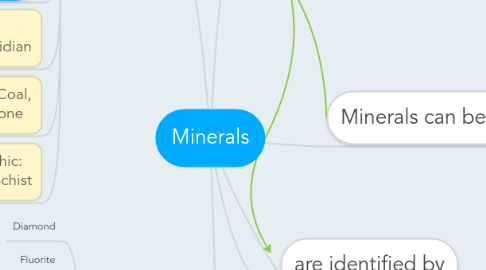Minerals
da Emily DeVore


1. Examples
1.1. Diamond
1.2. Fluorite
1.3. Calcite
1.4. Quartz
1.5. Talc
1.6. Pyrite
1.7. Kaolinite
1.8. Dolomite
1.9. Gold
1.10. Halite
1.11. Topaz
1.12. Corundum
1.13. Feldspar
1.14. Gypsum
2. Rocks
2.1. Minerals can be found in rocks
2.2. Three types of rocks: Igneous, Sedimentary, Metamorphic
2.3. How are they formed?
2.4. Igneous: Cooling magma
2.5. Sedimentary: Layering of sand, sediments, shells, plants, and dead animals.
2.6. Metamorphic: High heat and high pressure
2.7. Examples
2.8. Examples of Igneous: Kimberlite, Gabbro, Obsidian
2.9. Examples of Sedimentary: Coal, Limestone, Phyllite, Sandstone
2.10. Examples of Metamorphic: Gneiss, Marble, Slate, Schist
3. Properties
3.1. Luster
3.1.1. Brilliant
3.1.2. Glassy
3.1.3. Dull
3.2. Transparency
3.2.1. Translucent
3.2.2. Transparent
3.2.3. Opaque
3.3. Color
3.3.1. Varies
3.4. Size
3.4.1. Varies
3.5. Crystalline Shape
3.5.1. Octahedron
3.5.2. Cube
3.6. Hardness
3.6.1. Mohs Hardness Scale
3.7. Reaction to acid
3.7.1. No reaction (does nothing)
3.7.2. Reaction (Fizzes/bubbles)
3.8. Streak color
3.8.1. Varies
